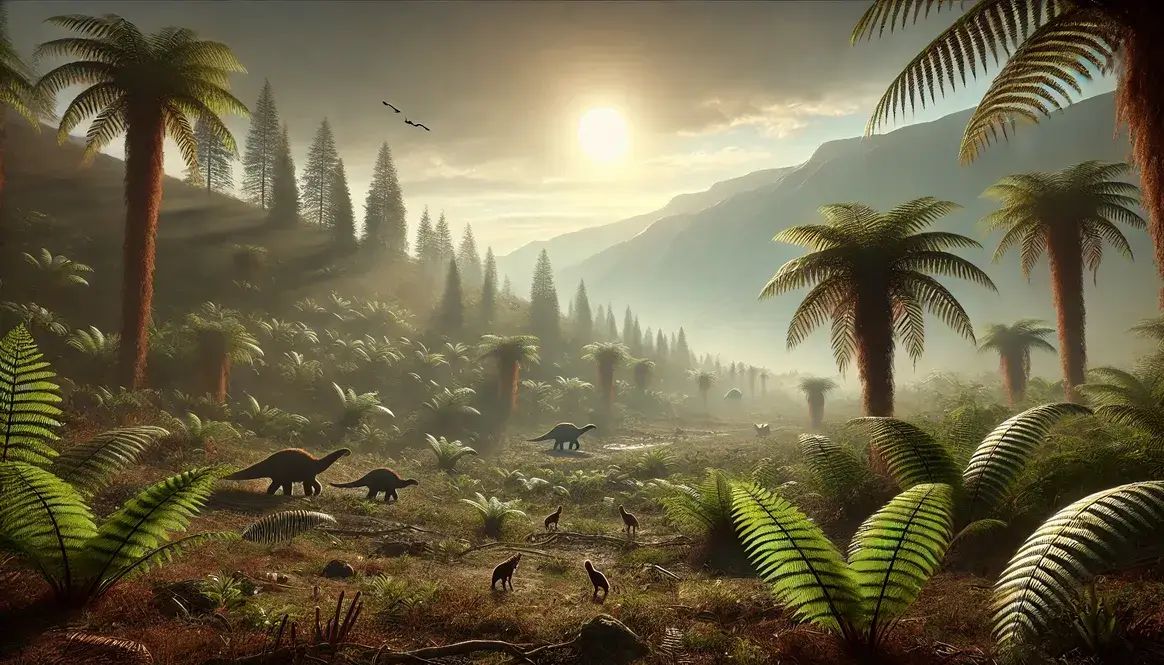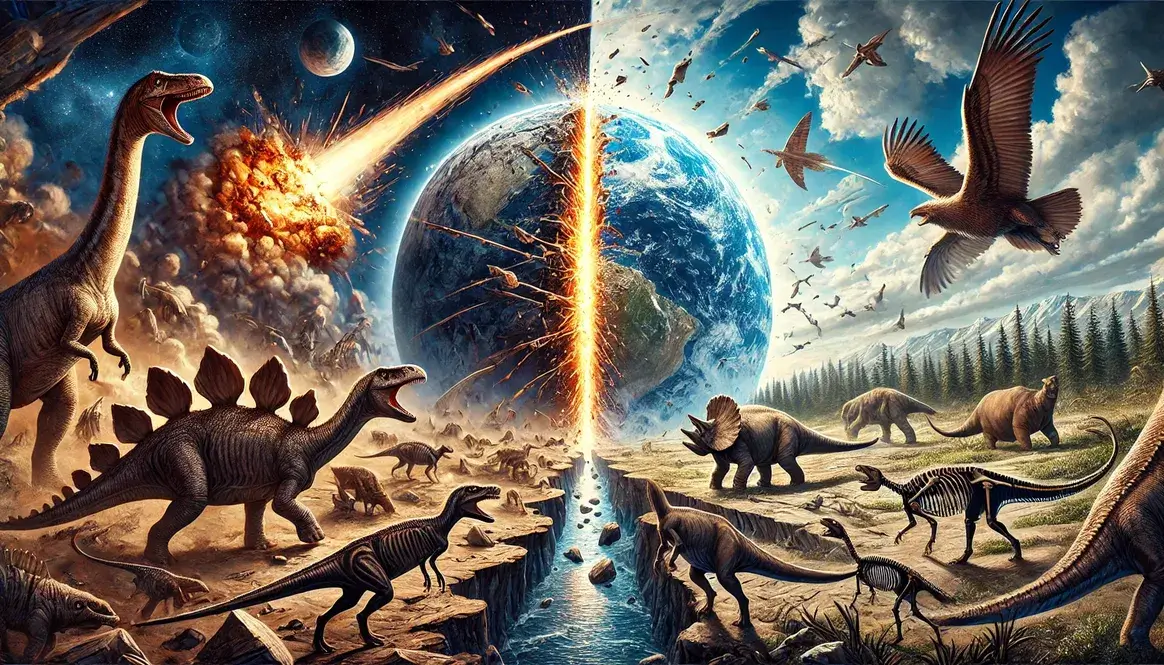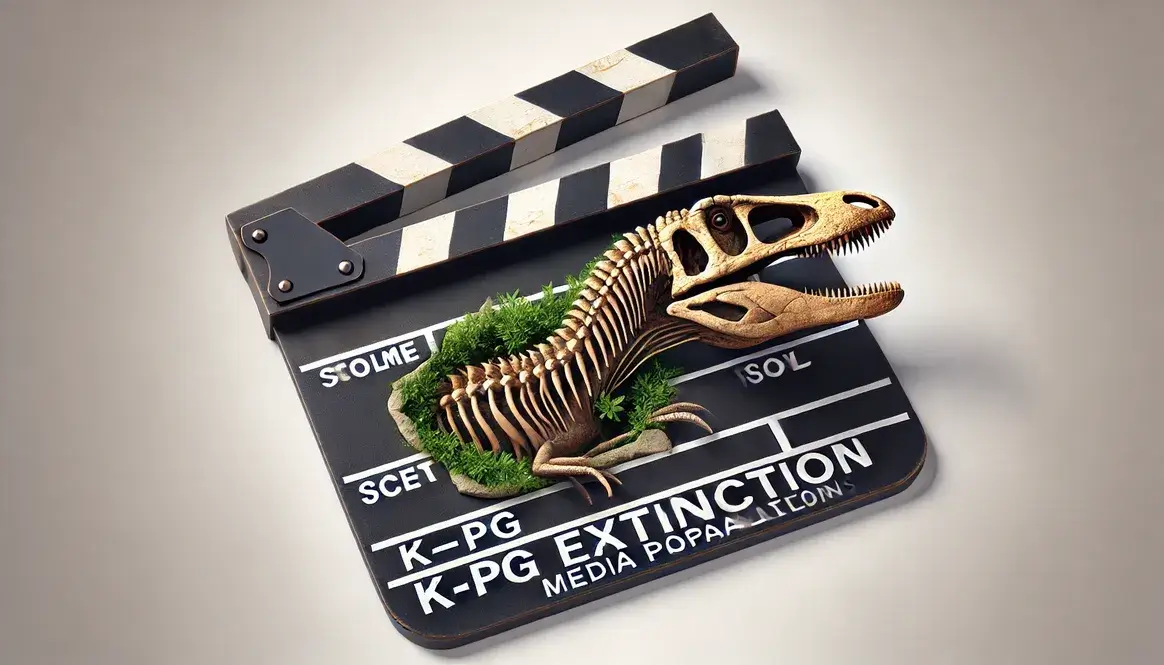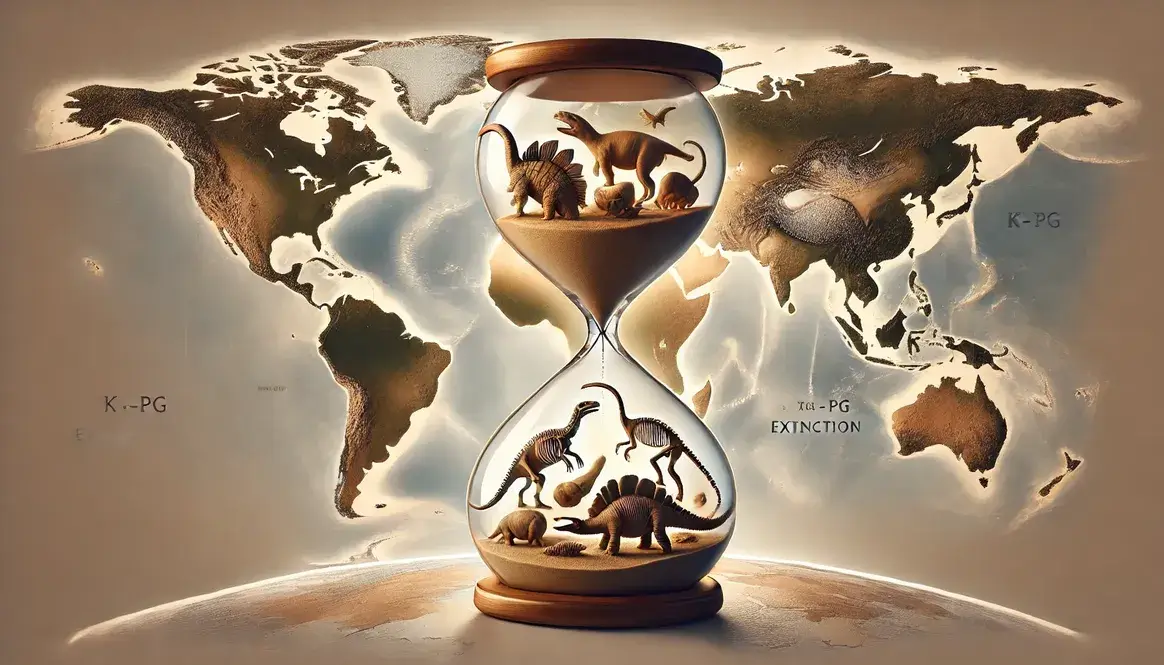The K-Pg extinction event dramatically altered Earth’s landscapes, reshaping ecosystems and paving the way for a new era. Let’s journey through time to understand how this cataclysmic event transformed our planet’s terrestrial environments.
The Late Cretaceous landscape
Before we explore how did K-Pg extinction change land, let’s paint a picture of Earth’s terrestrial ecosystems just before this world-altering event. The Late Cretaceous period was a time of lush greenery and diverse life forms, setting the stage for the dramatic changes to come.
Dominant vegetation
The Late Cretaceous world was bursting with plant life. Flowering plants, or angiosperms, had recently evolved and were spreading rapidly across the globe. These newcomers shared the landscape with ancient plant groups like conifers, cycads, and ferns.
Forests were a mix of familiar and strange trees. Imagine walking through a woodland with magnolias and palms growing alongside towering conifers like the dinosaur-era relative of the modern monkey puzzle tree. The ground was carpeted with ferns and early grasses, creating a diverse understory.
In drier areas, you might find early versions of plants we now associate with deserts and savannas. These plants were already developing adaptations to conserve water and survive in harsh conditions.
Climate conditions
The Late Cretaceous climate was generally warmer than today, with no polar ice caps. This created a more uniform global climate, but regional variations still existed.
| Climate Factor | Description |
|---|---|
| Temperature | Generally warm, averaging 5-10°C higher than today |
| CO2 Levels | About 4 times higher than pre-industrial levels |
| Sea Level | Up to 100 meters higher than present |
| Seasons | Less pronounced due to warmer global temperatures |
Rainfall patterns varied by region, but many areas experienced monsoon-like conditions. Seasonal variations were less extreme than today, especially in polar regions, which supported forests instead of ice sheets.
Soil characteristics
Cretaceous soils were as diverse as the landscapes they supported. In forested areas, rich, organic soils supported lush vegetation. These soils were teeming with life, from microscopic bacteria to burrowing insects and small mammals.
In drier regions, soils were often red in color due to high iron content. These soils supported hardy plants adapted to less fertile conditions.
Nutrient cycling in Cretaceous soils was influenced by the dominant plant life and the animals that lived there. Large dinosaurs played a role similar to modern large mammals, their droppings enriching the soil as they moved across the landscape.
Interestingly, the absence of grasses meant that soil erosion patterns were different from what we see today. Without the dense root systems of grasslands, some areas may have been more prone to erosion during heavy rains.
This vibrant, diverse terrestrial ecosystem was about to face its greatest challenge. The K-Pg extinction event would rewrite the rules of life on land, leading to the world we know today. But how exactly did this catastrophe change Earth’s landscapes? Let’s find out in the next section.
Immediate aftermath: How did K-Pg extinction change land
The K-Pg extinction event dramatically altered Earth’s terrestrial environments in a matter of hours to days. The Cretaceous-Paleogene extinction event triggered a cascade of changes that reshaped landscapes, decimated ecosystems, and set the stage for a new era of life on land.
Global wildfires
One of the most immediate and devastating effects of the K-Pg impact was the ignition of widespread wildfires. These weren’t your average forest fires – they were infernos on a global scale.
- Cause: Ejected impact debris reentering the atmosphere heated up, igniting fires across continents
- Extent: Estimates suggest up to 90% of the world’s forests may have burned
- Duration: Fires likely raged for weeks to months
The aftermath of these fires left a world of ash and charred landscapes. Lush forests were reduced to smoldering wastelands, dramatically altering habitats and food sources for surviving species.
Atmospheric changes
As if the fires weren’t enough, the impact also hurled massive amounts of dust and aerosols into the atmosphere. This created a “nuclear winter” effect that would last for years.
| Atmospheric Change | Effect on Land |
|---|---|
| Reduced sunlight | Lowered global temperatures |
| Acid rain | Increased soil acidity |
| Altered precipitation | Changes in local water cycles |
These atmospheric changes had profound effects on plant life. With reduced sunlight, many plants couldn’t photosynthesize effectively, leading to widespread die-offs. The K-Pg boundary in the geological record often shows a distinct layer of soot and ash, a stark reminder of this global catastrophe.
Mass die-offs
The combination of fires, climate change, and loss of plant life led to massive die-offs across the animal kingdom. This wasn’t just about the extinction of dinosaurs – it was a reset button for entire ecosystems.
The death of so many organisms had a significant impact on soil composition and nutrient cycles:
- Nutrient pulse: The sudden input of organic matter from dead plants and animals temporarily enriched soils.
- Disrupted food webs: With key species gone, nutrient cycling through food webs was severely disrupted.
- Altered decomposition: Changes in microbial communities affected how organic matter was broken down.
These mass die-offs created opportunities for surviving species, which would go on to repopulate and reshape the post-extinction world. But first, life had to navigate the challenging early recovery phase, which we’ll explore next.
Early recovery phase
The years immediately following the K-Pg impact were a time of profound change and gradual recovery. As the dust settled and fires died out, life began the slow process of reclaiming the altered landscape.
Pioneer species
In the wake of widespread devastation, hardy pioneer species were the first to recolonize the barren landscapes. These plants were the frontline soldiers in the battle to restore life to the scorched Earth.
- Ferns: Among the first to return, ferns thrived in the ash-rich soil.
- Mosses: These simple plants helped stabilize the soil and retain moisture.
- Fungi: Though not plants, fungi played a crucial role in breaking down dead organic matter.
These early colonizers paved the way for more complex plant communities to follow. Their ability to survive in harsh conditions made them the perfect candidates to kickstart the recovery process.
Soil and water changes
The K-Pg extinction event significantly altered soil composition and water systems, creating a new environmental context for recovering ecosystems.
Soil changes:
- Increased acidity due to acid rain
- Higher metal content from impact debris
- Altered microbial communities
Water system changes:
- Disrupted river flows due to landscape alterations
- Changes in groundwater chemistry
- Shifts in local water cycles
These changes in soil and water had far-reaching effects on the types of plants and animals that could thrive in the post-impact world. The effects by region varied, with some areas recovering faster than others based on local conditions.
Climate fluctuations
The years following the impact were marked by significant climate instability. The “impact winter” gradually gave way to a period of climate fluctuations that would persist for thousands of years.
| Time Period | Climate Condition |
|---|---|
| 0-5 years | Severe global cooling |
| 5-100 years | Gradual warming with fluctuations |
| 100-1000 years | Stabilization towards new normal |
Temperature swings and erratic precipitation patterns made life challenging for surviving species. However, these fluctuations also drove rapid evolution and adaptation among the survivors, setting the stage for the diverse ecosystems that would eventually emerge.
As the early recovery phase progressed, the groundwork was laid for more complex ecosystems to develop. The next phase of recovery would see the return of forests and the emergence of new dominant species, reshaping the face of the Earth once again.
Mid-term recovery
As decades turned into centuries, the Earth’s landscapes continued to evolve. This mid-term recovery phase saw dramatic shifts in vegetation and ecosystems, laying the foundation for the modern world we know today.
Fern spike
One of the most striking features of the post-impact world was the “fern spike” – a period when ferns dominated the landscape. This phenomenon is clearly visible in the fossil record and tells us a lot about how life bounces back after catastrophe.
Ferns thrived for several reasons:
- Resilient spores: Fern spores could survive extreme conditions
- Fast growth: Ferns reproduce and spread quickly
- Adaptability: They could grow in nutrient-poor soils
The fern spike lasted for thousands of years in some areas, creating vast “fern prairies” where once diverse forests stood. This period was crucial in stabilizing soils and paving the way for more complex plant communities to return.
Return of forests
As conditions improved, larger plants began to reestablish themselves. The return of forests was a gradual process, with different plant groups making comebacks at different rates.
Early returners:
- Conifers
- Cycads
- Some flowering plants
Later arrivals:
- More diverse angiosperm trees
- Complex understory plants
It took approximately 10,000 years for the first recognizable forests to appear after the K-Pg extinction. These new forests were different from their Cretaceous predecessors, with new species compositions and structures. The latest research on K-Pg extinction continues to refine our understanding of this recovery process.
Shifts in river systems
The dramatic changes in vegetation had profound effects on river systems and erosion patterns. Without the stabilizing effect of large trees and their root systems, rivers behaved differently.
Initially, increased erosion led to:
- Wider, shallower river channels
- More sediment deposition in lowlands
- Formation of new floodplains
As forests returned, river systems began to stabilize. However, the new vegetation patterns meant that many rivers followed different courses than before the extinction event. These changes in waterways had knock-on effects for the entire ecosystem, influencing everything from soil fertility to animal migration patterns.
The mid-term recovery phase set the stage for the long-term transformations that would shape the modern world. As we’ll see in the next section, these changes would continue for millions of years, leading to the diverse and complex ecosystems we see today.
Long-term transformations
Over thousands to millions of years, the Earth’s landscapes underwent profound changes. These long-term transformations shaped the world we know today, creating new ecosystems and climate patterns that would define the post-K-Pg world.
Evolution of new plant communities
The plant communities that emerged in the aftermath of the K-Pg extinction were markedly different from their Cretaceous predecessors. This shift in vegetation had far-reaching consequences for the entire ecosystem.
Key changes in plant communities:
- Dominance of flowering plants (angiosperms)
- Decline of cycads and certain conifer groups
- Emergence of new plant families and genera
The rise of grasslands was perhaps the most significant long-term change. These vast expanses of grass-dominated ecosystems didn’t exist before the K-Pg extinction. Their emergence altered everything from soil composition to animal evolution, shaping the development of many modern mammal groups.
Forests, too, were different. The new forests were more diverse, with a greater variety of flowering trees. This diversity provided new niches for animal life, contributing to the evolution of new species in the post-extinction world.
Climate stabilization
After millennia of fluctuations, the Earth’s climate eventually settled into a new equilibrium. This stabilization was crucial for the development of complex ecosystems.
The new climate was characterized by:
- Generally cooler temperatures than the Cretaceous
- More pronounced seasons, especially in higher latitudes
- Establishment of polar ice caps
These changes were driven by a combination of factors, including:
| Factor | Effect on Climate |
|---|---|
| Reduced CO2 levels | Global cooling |
| Continental drift | Changes in ocean currents and weather patterns |
| Evolution of new plant communities | Alterations in carbon cycle and local climates |
The stabilization of climate allowed for the development of diverse biomes across the globe, from tropical rainforests to temperate grasslands and polar tundra.
Soil development
As plant and animal communities evolved, so did the soils beneath them. This co-evolution of life and soil was a slow process that played out over millions of years.
New soil types emerged, each adapted to the particular plants and climate of their region. For example:
- Prairie soils: Rich in organic matter, these soils developed under grasslands.
- Forest soils: With distinct layers, these soils reflected the complex ecology of woodland environments.
- Desert soils: In arid regions, unique soil types formed, often rich in minerals but poor in organic matter.
The development of these varied soil types was crucial for supporting the diverse ecosystems that emerged in the post-K-Pg world. Soil microbes played a key role in this process, forming complex relationships with plant roots and contributing to nutrient cycling.
These long-term transformations set the stage for the world we know today. But the story doesn’t end here. The changes brought about by the K-Pg extinction created new opportunities for surviving species, leading to an explosion of diversity that would shape the future of life on Earth.
Opportunities for surviving species
The dramatic changes in terrestrial environments following the K-Pg extinction created a world of opportunities for surviving species. This new landscape, with its altered ecosystems and vacant niches, became a stage for rapid evolution and diversification.
Mammalian diversification
Mammals, once living in the shadow of dinosaurs, found themselves in a world ripe with possibilities. The extinction of large reptiles left numerous ecological niches open, and mammals were quick to adapt and fill these roles.
Key factors in mammalian success:
- Adaptability to varied diets
- Warm-blooded metabolism
- Care for young, increasing survival rates
Mammals evolved to fill roles previously occupied by dinosaurs, from small insectivores to large herbivores and apex predators. This diversification led to the evolution of many familiar groups we see today:
- Primates
- Rodents
- Carnivores (like cats and dogs)
- Hoofed mammals (like horses and deer)
The emergence of grasslands provided new opportunities for grazing mammals, leading to the evolution of teeth adapted for grinding tough plant material. This adaptation allowed mammals to exploit a food source that was largely unavailable in the pre-extinction world.
Avian adaptations
Birds, the surviving descendants of theropod dinosaurs, also underwent significant evolution in the post-K-Pg world. With the extinction of their larger relatives, birds found new opportunities to diversify and adapt.
Birds evolved a variety of specialized beaks and feeding strategies to take advantage of different food sources:
| Beak Type | Adaptation |
|---|---|
| Hooked | Tearing meat (raptors) |
| Conical | Cracking seeds |
| Long, thin | Probing for insects |
| Flat, broad | Filter feeding |
Flight abilities also diversified, with some birds becoming powerful long-distance migrants, while others became flightless to exploit ground-based niches. The evolution of new species of birds led to the incredible diversity we see today, from tiny hummingbirds to large flightless birds like ostriches.
Insect and plant coevolution
The relationship between insects and flowering plants, which had begun in the Cretaceous, continued to evolve and intensify after the K-Pg extinction. This coevolution played a crucial role in shaping modern terrestrial ecosystems.
Insects adapted to new plant species, developing specialized mouthparts for feeding on different types of flowers. In turn, plants evolved new strategies to attract specific pollinators or deter herbivorous insects:
- Complex flower structures
- New types of nectar and pollen
- Chemical defenses against herbivory
This intricate dance between insects and plants led to the development of highly specialized relationships. For example, many orchids evolved to mimic specific insect species, ensuring targeted pollination.
The diversification of insects also had profound effects on soil development and nutrient cycling. As decomposers and soil dwellers, insects played a crucial role in breaking down organic matter and enriching the soil, further supporting the growth of new plant communities.
The opportunities created by the K-Pg extinction event ultimately led to the rich biodiversity we see in today’s world. From the smallest insects to the largest mammals, life found a way to adapt, evolve, and thrive in the transformed terrestrial environments of the post-extinction Earth.









